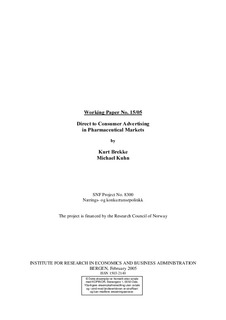Direct to consumer advertising in pharmaceutical markets
Working paper

Åpne
Permanent lenke
http://hdl.handle.net/11250/165716Utgivelsesdato
2005-02Metadata
Vis full innførselSamlinger
- Working papers (SNF) [809]
Sammendrag
We study effects of direct-to-consumer advertising (DTCA) in the prescription drug market. There are two pharmaceutical firms providing horizontally differentiated (branded) drugs. Patients differ in their susceptability to the drugs. A fraction of the patients know their ill and visit a physician. Visits from the residual fraction ('potential' patients) can be induced by DTCA, if allowed. Physicians perfectly observe the patients' disease type, but rely on information to prescribe the correct drug. Drug information is conveyed by marketing (detailing), creating a monopolistic (captive) and a competitive (selective) segment of physicians. First, we show that detailing, DTCA and price (if not regulated) are complementary strategies for the firms. Thus, allowing DTCA induces more detailing and higher prices. Second, firms benefit from DTCA if detailing competition initially is not too fierce, which is true if the advertising technology is sufficiently costly. Finally, DTCA is likely to be welfare improving only if the copayment rate is sufficiently high. If insurance is generous, detailing and possibly also DTCA tend to be excessive.
Utgiver
SNFSerie
Working paper2005:15